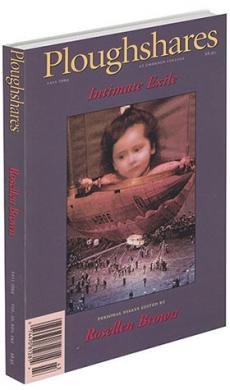rev. of The Sixteen Pleasures by Robert Hellenga
The Sixteen Pleasures
A novel by Robert Hellenga. Soho Press, $22.00 cloth. Reviewed by Joan Wickersham.
A character in
The Sixteen Pleasures tells of a shop in Rome where petitioners in marital annulment cases can buy old postcards, old inks, and old uncanceled stamps, for the purpose of fabricating evidence from the past. This desire to rewrite the past, to make it turn out differently, is a theme that resonates throughout Robert Hellenga’s elegant and original first novel.
Margot Harrington, a young American book conservator, travels to Florence to help rescue artworks damaged in the great flood of 1966. She is journeying into her own past as well, searching for the audacious life she might have led if she had not been forced by her mother’s fatal illness to leave Italy years before. At the same time, she recognizes that the notion of a “road not taken” is naive fantasy. “Mama always maintained that anyone who’d heard Frost read ‘The Road Not Taken’ . . . would know that the last line was ironic, a joke, but I’d never understood what she meant till now. There is no ‘road not taken,’ there’s only this road.”
She falls in love with Sandro Postiglione, a worldly and affectionate Italian art restorer who lives for the daily pleasures of food, love, and conversation, “content to let his little boat drift wherever it would.” And while living within an order of historically independent and intelligent nuns, she comes upon the only extant copy of the notorious
Sonetti lussuriosi — sixteen bawdy sonnets by Aretino, with joyously explicit engravings after Giulio Romano’s drawings. She receives from the abbess a subtle and difficult commission: to circumnavigate the bishop of Florence, who wants to control the destinies of both book and convent, and to sell the Aretino for the benefit of the nuns.
As the story unfolds in surprising and wholly satisfying ways, the novel becomes a meditation on erotic love, on the bonds between parents and children, on the definition of “home,” and, most importantly and insistently, on the shape of human lives. Do we control our own destinies, or are we at the mercy of other people and events? Or, as the abbess suggests, perhaps “we can’t make any sense out of life until we give up our deepest hopes, until we stop trying to arrange everything to suit us.”
Yet for all the ambitiousness of his themes, Hellenga is a refreshingly understated stylist. The novel is carefully structured, but it has the feeling of a leisurely, almost meandering journey, with dozens of fascinating side trips. The narrative roams from the posturing and politicking of academics to the tortuous paradoxes of canon law, to the arcane challenges of stripping water-damaged frescoes from plaster walls, to a blow-by-blow description of bookbinding that is as gripping as any thriller, to a wonderfully funny scene in which Sandro’s mother confronts Margot with the erotic engravings: “You do these things with my son? . . . And this? . . . And this?”
Longing for the past and at the same time longing to have done it differently, haunted by her dead mother’s voice and by her absence, in love with Italy but nobody’s fool, Margot is a complex and sympathetic character. Her cool, precise narration helps to make this a novel of self-discovery in which the pilgrim is as interesting as the pilgrimage.
Joan Wickersham’s fiction has appeared in The Hudson Review, Story, Best American Short Stories 1990,
and The Graywolf Annual Eight.
Her first novel, The Paper Anniversary,
was published by Viking last year.

